Guitar tablature, or “guitar tabs,” is a simple and effective way for anyone to start learning guitar and playing their favorite songs quickly. Think of guitar tabs as a visual shortcut to music notation, specifically designed for guitarists. While they share some similarities with traditional music notation, the beauty of guitar tabs lies in their directness: they show you exactly where to place your fingers on the guitar to play specific notes and chords.
This is incredibly helpful because, unlike instruments with fixed pitches, the guitar allows you to play the same note in multiple locations on the fretboard. Learning how to read guitar tabs empowers beginners to bypass the complexities of standard music notation and dive straight into playing music. No prior music reading experience is needed!
At guitarplayers.net, we believe in making guitar learning accessible to everyone. That’s why we’re breaking down how to read guitar tablature step-by-step. Guitar tabs are versatile – they can represent both chords and single notes, making them the fastest route to learning your favorite songs, regardless of genre. All you need is a basic understanding of your guitar’s strings and frets, and you’re ready to go.
Ready to unlock the world of guitar tabs? Let’s get started and explore what guitar tabs are all about and how they can help you on your musical journey.
What is Guitar Tablature?
Guitar tablature is essentially a visual representation of music written specifically for the guitar. Imagine it as a map guiding your fingers across the fretboard. A standard guitar tab is composed of six horizontal lines. Each of these lines corresponds to one of the six strings on your guitar. When you look at a guitar tab, you’re reading it from top to bottom, just like you view your guitar strings when holding the instrument.
The topmost line in the tab represents the high E string (the thinnest string), followed by lines for the B, G, D, A, and low E strings (the thickest string) as you move downwards. This arrangement mirrors the actual layout of your guitar strings when you look down at your instrument in playing position. Therefore, think of guitar tablature as your personal roadmap, providing you with the most direct path to learning and playing guitar songs efficiently.
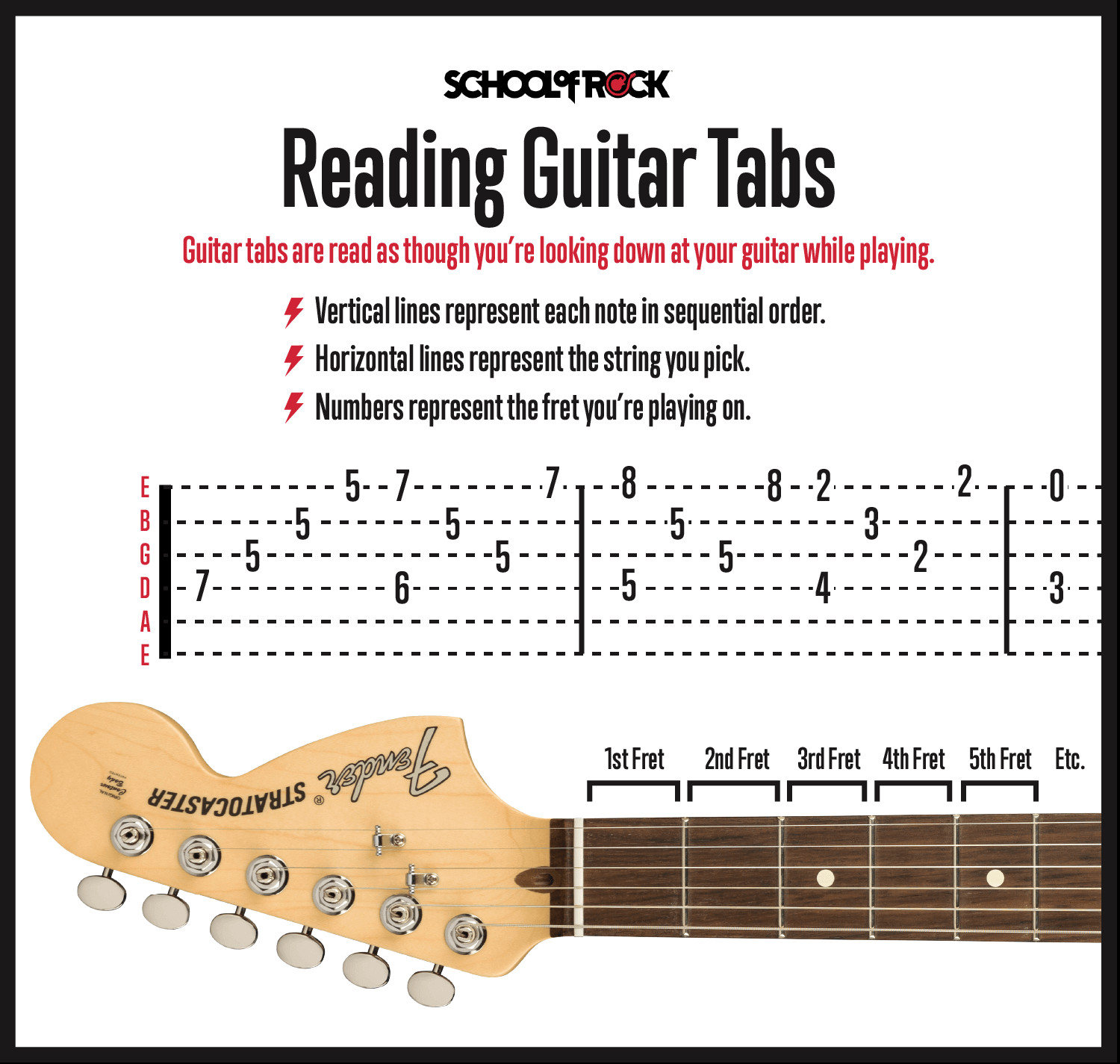 Guitar Tab Lines Representing Strings
Guitar Tab Lines Representing Strings
Guitar tab lines representing the six guitar strings, from the high E string at the top to the low E string at the bottom, mirroring the guitar’s string layout.
Understanding Guitar Tab Numbers: Frets
As you explore guitar tablature, you’ll notice numbers appearing on each of the six horizontal lines. These numbers are your fret indicators. They tell you which fret to press down on each string. Frets are the metal strips running perpendicular to the guitar strings along the fretboard. They are numbered from 0 up to 24 (or sometimes more, depending on the guitar), starting from the nut (the white piece closest to the headstock of your guitar) and extending down the neck towards the guitar body.
When you see a “0” on a string line in a tab, it signifies playing that string “open.” This means you pluck or pick the string without pressing down on any fret with your fretting hand. If you see a “1”, it means you should press down on the first fret behind the nut. Following this pattern, “2” indicates the second fret, “3” the third fret, and so on. Therefore, when learning how to read guitar tabs, it’s crucial to remember that these numbers directly correspond to the fret numbers on your guitar neck.
Reading Guitar Tabs from Left to Right: Rhythm and Timing
Guitar tablature is designed to be read from left to right, just like standard written text. The notes and symbols you encounter are presented in chronological order, indicating the sequence in which they should be played in a song. Timing in tabs is represented horizontally, with notes positioned further to the right occurring later in the music. While tabs don’t explicitly show note durations like standard notation, the horizontal spacing can sometimes give a general sense of rhythm. However, listening to the song is crucial for understanding the precise timing and rhythm.
When you see numbers stacked vertically on different lines within a tab, it indicates a chord. A chord is played by strumming all the strings with vertically aligned numbers together simultaneously. Guitar tab notation is particularly advantageous for beginners compared to standard notation because it visually represents the notes required to form a chord and, most importantly, where to find those notes on your guitar fretboard.
Guitar Tab Chords Explained
In guitar tabs, chords are easily identifiable as they are represented by numbers stacked vertically across multiple string lines. This vertical alignment signifies that all the indicated notes should be played together, forming a chord. To play a chord from a tab, you would fret all the strings indicated by the numbers in a vertical stack and then strum across those strings.
The beauty of guitar tabs for chords is that they remove the guesswork for beginners. Instead of needing to memorize complex chord diagrams or understand chord theory, tabs visually show you precisely where to place your fingers to create a specific chord shape. This directness makes learning chords much more intuitive and faster for new guitarists.
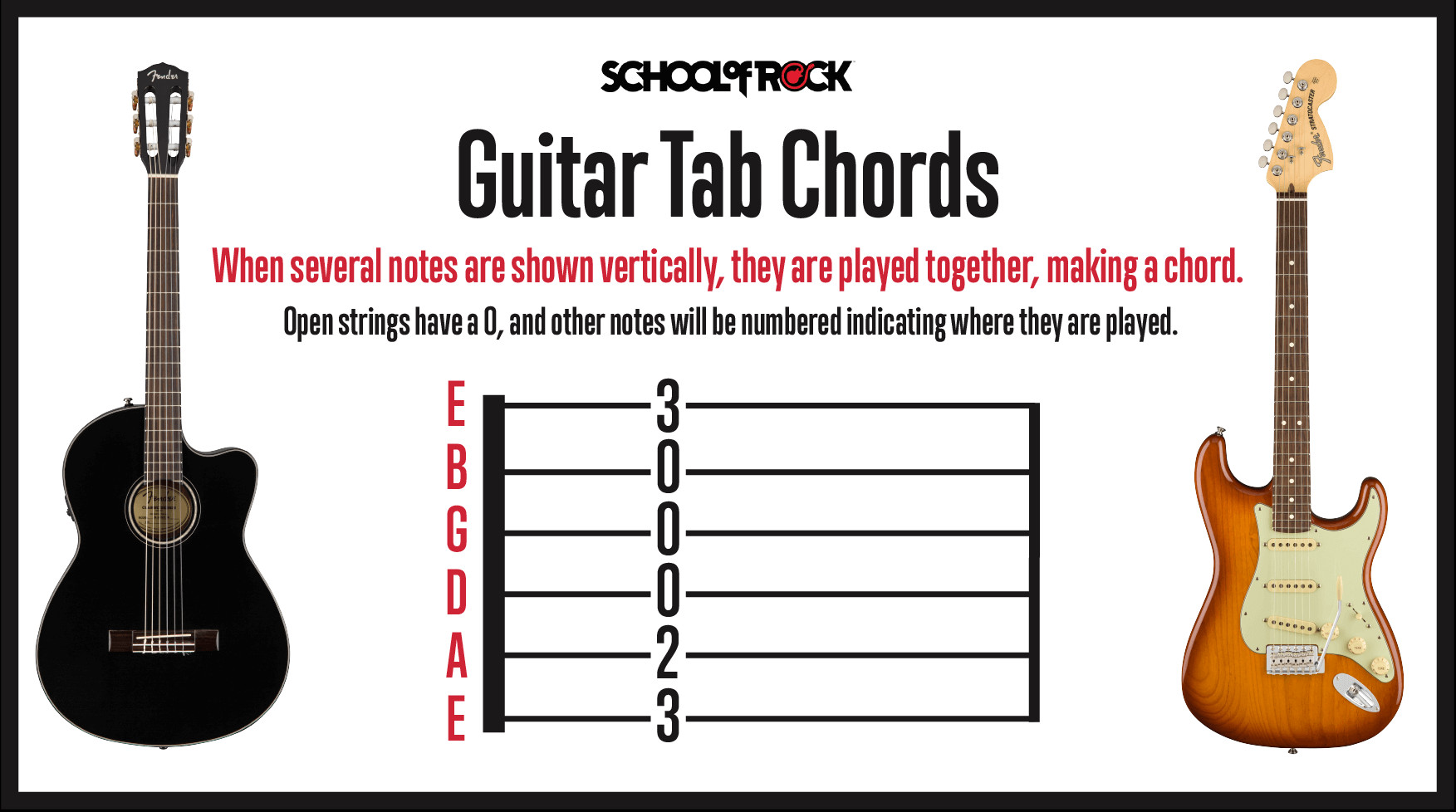 Guitar Tab Chords Diagram
Guitar Tab Chords Diagram
Example of guitar tab chords, showing vertically stacked numbers indicating notes to be played together as a chord.
Guitar Tab Riffs and Melodies
Guitar tabs are not just for chords; they are equally effective for learning riffs and melodies. Riffs, common in genres like rock and blues, are short, repeating musical phrases often built from a combination of single notes and partial chords, such as power chords. In guitar tabs, riffs are displayed as a sequence of numbers and symbols read from left to right, just like any other part of the tab.
Melodies, on the other hand, are typically single-note lines that form the main tune of a song. In tabs, melodies appear as a single line of numbers on one or more of the string lines, showing the sequence of notes to play to create the melody. Even within riffs and melodies, the principle of vertical alignment still applies. If you encounter vertically aligned numbers within a riff or melodic passage, it means those notes should be played simultaneously as part of the riff or harmony.
Guitar Tab Staff: Strings, Not Notes
It’s important to understand that the “staff” in guitar tablature is different from the staff used in standard musical notation. In standard notation, the lines of the staff represent musical pitches, indicating the highness or lowness of notes. However, in guitar tabs, the six horizontal lines of the staff represent the six strings of the guitar, not musical pitches directly.
The top line is always the high E string, and the bottom line is always the low E string. This direct string-to-line correspondence is what makes guitar tabs so intuitive for guitarists. To further avoid confusion with standard notation, guitar tabs are often labeled with “TAB” at the beginning of the staff. This labeling clearly distinguishes it from traditional musical scores and reinforces that you are reading guitar-specific notation.
Guitar Frets in Detail: Semitones and Markers
Guitar frets are more than just metal strips; they are the foundation of pitch variation on the guitar. Each fret represents one semitone, or half step, in musical distance. Moving from one fret to the next changes the pitch of the string by a semitone. Twelve semitones make up a full octave, and most guitars have between 19 and 24 frets, giving a wide range of notes.
To help guitarists navigate the fretboard, most guitars have fret markers or inlays. These are typically dots or shapes inlaid into the fretboard or side of the neck at specific fret positions – usually the 3rd, 5th, 7th, 9th, and 12th frets, with double markers often at the 12th fret to denote the octave. These markers are visual aids to quickly identify fret positions while playing, making it easier to jump to the correct area of the neck as indicated by guitar tabs.
Open Strings (0) in Guitar Tabs
The number “0” appearing on a string line in guitar tablature is a fundamental notation. It signifies an open string. Playing an open string means you pluck or pick the string without pressing down on any fret with your fretting hand. When you see a “0” in a tab, you simply select the corresponding string and play it without fretting any note. Open strings are essential components of many guitar chords and riffs, and the “0” notation is a clear and concise way to indicate them in tabs.
Guitar Tabs vs. Chord Charts: Key Differences
While both guitar tabs and chord charts are resources for guitarists, they serve different purposes and present information in distinct ways. A chord chart is a visual diagram that displays the fretboard of the guitar and indicates where to place your fingers to play a specific chord. Chord charts often include finger numbers to guide finger placement and may only show the basic chord shape. They are excellent for quickly learning chord voicings and shapes.
Guitar tabs, on the other hand, provide a more detailed representation of music. They show not only chords but also melodies, riffs, and specific techniques. Tabs indicate the exact frets and strings to play for entire songs, including rhythmic information (though often implied rather than explicitly notated). While chord charts are great for learning basic chord shapes, guitar tabs offer a comprehensive roadmap for playing full songs and musical pieces, including nuances beyond just basic chords. Often, chord charts are used in conjunction with guitar tabs, especially for beginners. Chord charts might be placed above lyrics to indicate chord changes, while the tab provides the detailed musical arrangement.
Fingering Numbers in Chord Charts (Not Tabs)
Chord charts sometimes include numbers within the chord diagrams. These numbers indicate fingering, not fret numbers. This is a crucial distinction from guitar tabs. In chord charts, “1” usually represents the index finger, “2” the middle finger, “3” the ring finger, and “4” the pinky finger of your fretting hand. These finger numbers are guides to help you learn efficient and common fingerings for chords.
Guitar tabs do not use finger numbers. The numbers in tabs always refer to fret numbers. If you see a “1” in a guitar tab, it means fret the first fret, not use your index finger. Understanding this difference is key to correctly interpreting both chord charts and guitar tabs.
Guitar Tab Symbols and Techniques: Beyond the Basics
Beyond numbers and lines, guitar tabs use a variety of symbols to represent different guitar techniques and musical articulations. Learning to recognize and understand these symbols is essential for accurately interpreting guitar tabs and making your playing sound authentic. These symbols convey techniques like bends, slides, hammer-ons, pull-offs, vibrato, and muting, which are crucial for expressive guitar playing, especially in genres like rock, blues, and metal.
Before diving into techniques, it’s always a good practice to ensure your guitar is properly tuned. Playing with correct tuning is fundamental, regardless of the technique you’re using. If your guitar is out of tune, even perfectly executed techniques will not sound right.
Muting Techniques in Guitar Tabs
Muting is a fundamental guitar technique, particularly vital in genres like rock, metal, and funk. Muting involves dampening the strings to control sustain, eliminate unwanted noise, and create percussive or rhythmic effects. Guitar tabs use specific symbols to indicate different types of muting.
Palm Muting (P.M.)
Palm muting is a widely used technique, especially in rock and metal genres, to create a chunky, rhythmic sound. It’s achieved by resting the edge of your picking hand’s palm lightly on the strings near the bridge while picking. The amount of pressure applied by your palm determines the degree of muting – heavier pressure creates a tighter, more dampened sound, while lighter pressure allows more of the note to ring out.
In guitar tabs, palm muting is typically indicated by the abbreviation “P.M.” written above the tab staff, usually extending over the section where palm muting should be applied.
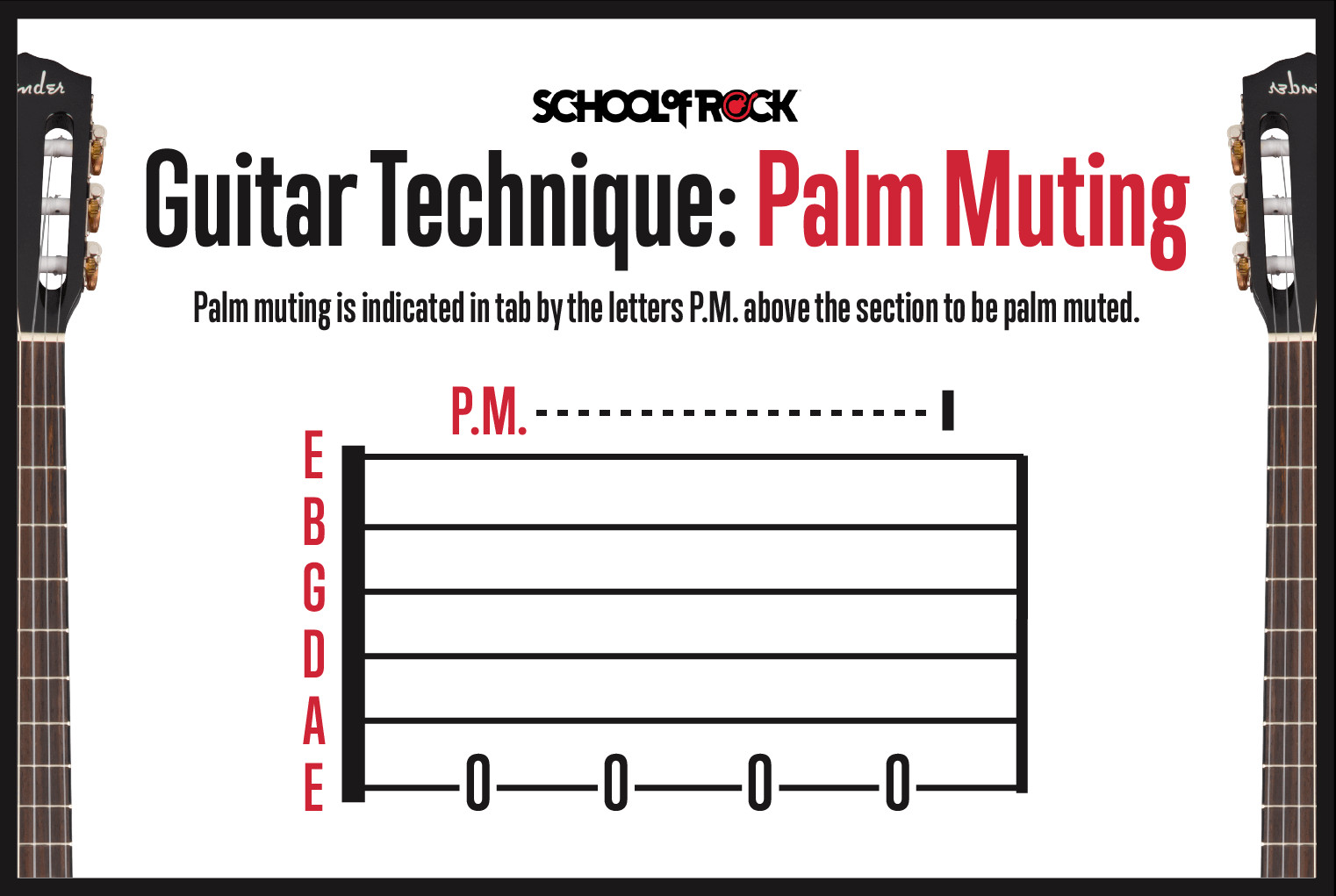 Guitar Palm Muting Technique
Guitar Palm Muting Technique
Guitar tab example showing “P.M.” notation above the staff to indicate palm muting technique.
Muted Notes (X)
Another type of muting is indicated by an “X” symbol in place of a fret number on the tab staff. This “X” signifies a muted note or a “dead note.” To play a muted note, you lightly touch the indicated string with your fretting hand finger without pressing down hard enough to fret a specific note. Then, you pick the string as usual. This creates a percussive, muted sound, rather than a clear, pitched note. Muted notes are often used rhythmically, adding texture and groove to guitar parts.
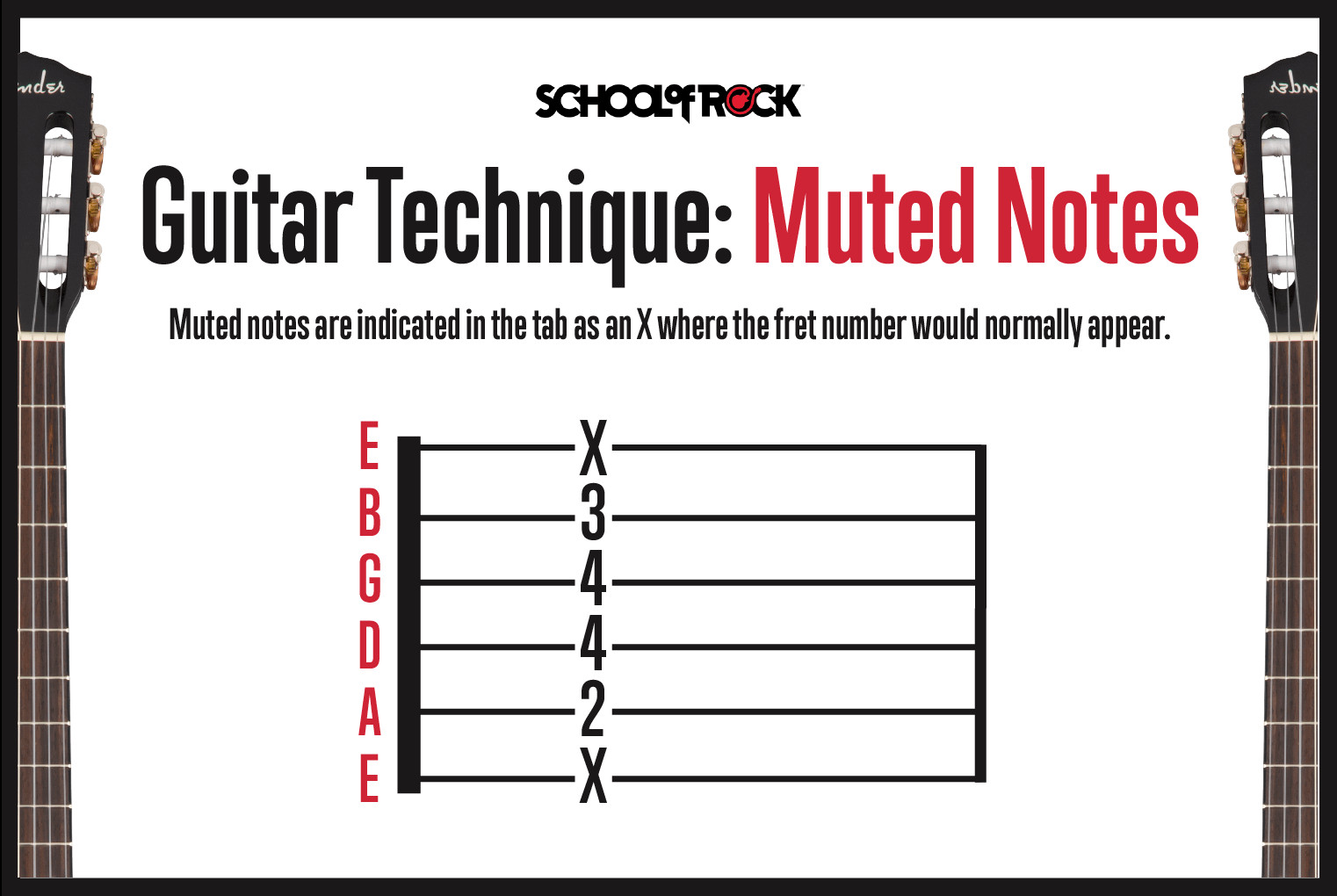 Guitar Muted Notes Technique
Guitar Muted Notes Technique
Guitar tab example using “X” symbols to represent muted notes, creating a percussive sound.
Bending Guitar Strings in Tabs
String bending is a cornerstone of expressive guitar playing, especially in blues, rock, and country. Bending involves pushing or pulling a string sideways across the fretboard to raise its pitch, creating a vocal-like, emotive sound.
In guitar tabs, bends are indicated by a curved arrow originating from the note being bent. The arrow usually points upwards, signifying an upward bend in pitch. Often, the tab will also indicate the bend amount, such as “½” for a half-step bend (one fret up in pitch) or “full” or “1” for a whole-step bend (two frets up in pitch). Sometimes, the tab will show a target note in parentheses to indicate the pitch you should bend up to.
String Bending Technique
To bend a string, you fret the note as usual and then, instead of just picking, you use your fretting finger(s) to push or pull the string across the fretboard. For most strings (except the low E), you typically push upwards towards the ceiling. For the low E string, you usually bend downwards towards the floor. It’s crucial to apply smooth, consistent pressure throughout the bend to achieve a controlled and musical pitch change. Using multiple fingers to bend (e.g., using your ring finger as the main bending finger and your middle and index fingers for support) can add strength and control to your bends.
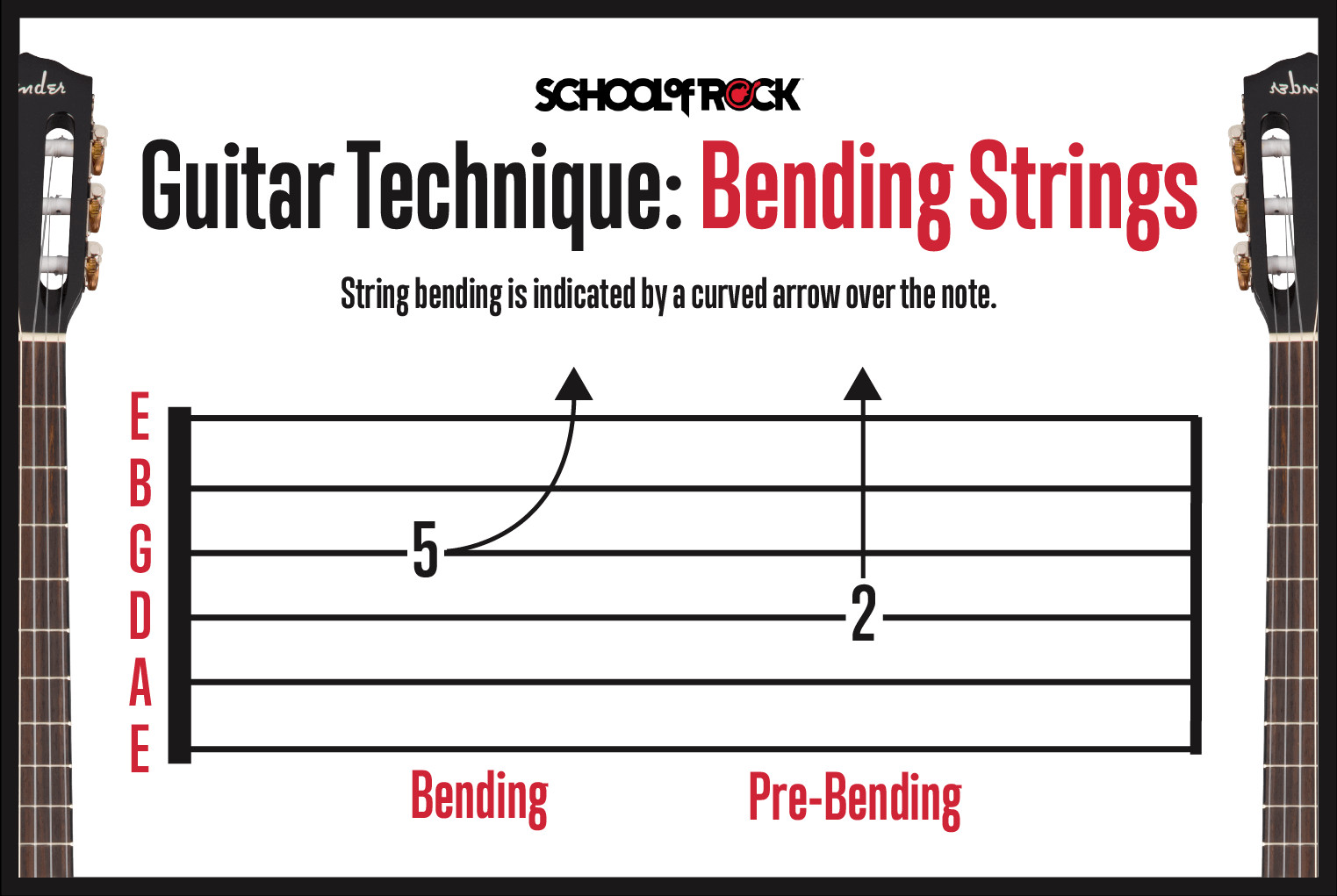 Guitar String Bending Technique
Guitar String Bending Technique
Guitar tab example showing a curved arrow above a note to indicate a string bend technique.
Pre-Bending
Another bending variation you might encounter in guitar tabs is the pre-bend. A pre-bend is when you bend the string before picking the note and then pick the already bent string. Often, after picking a pre-bent note, you will then release the bend, letting the string return to its original pitch. This creates a distinctive “wah” or crying sound.
Pre-bends are typically notated with an upward arrow indicating the bend amount (like regular bends), followed by “r” for “release” after the pre-bent note. Sometimes, a curved arrow pointing downwards after the note will indicate the release visually. Pre-bends can also be bent up to one pitch and then further bent to a higher target pitch, adding even more expressive possibilities.
Sliding Guitar Notes in Tabs
Sliding is another essential guitar technique that creates a smooth transition between notes. It involves playing a note and then, without lifting your fretting finger, sliding that finger along the string to another fret to sound a new note.
In guitar tabs, slides are represented by a line connecting two notes. The line can be slanted upwards (/) to indicate a slide up to a higher-pitched note or slanted downwards () to indicate a slide down to a lower-pitched note.
Slide Up
A slide up is when you slide from a lower-pitched note to a higher-pitched note. In guitar tabs, a slide up is shown by a line slanting upwards (/) connecting the fret number you are sliding from to the fret number you are sliding to.
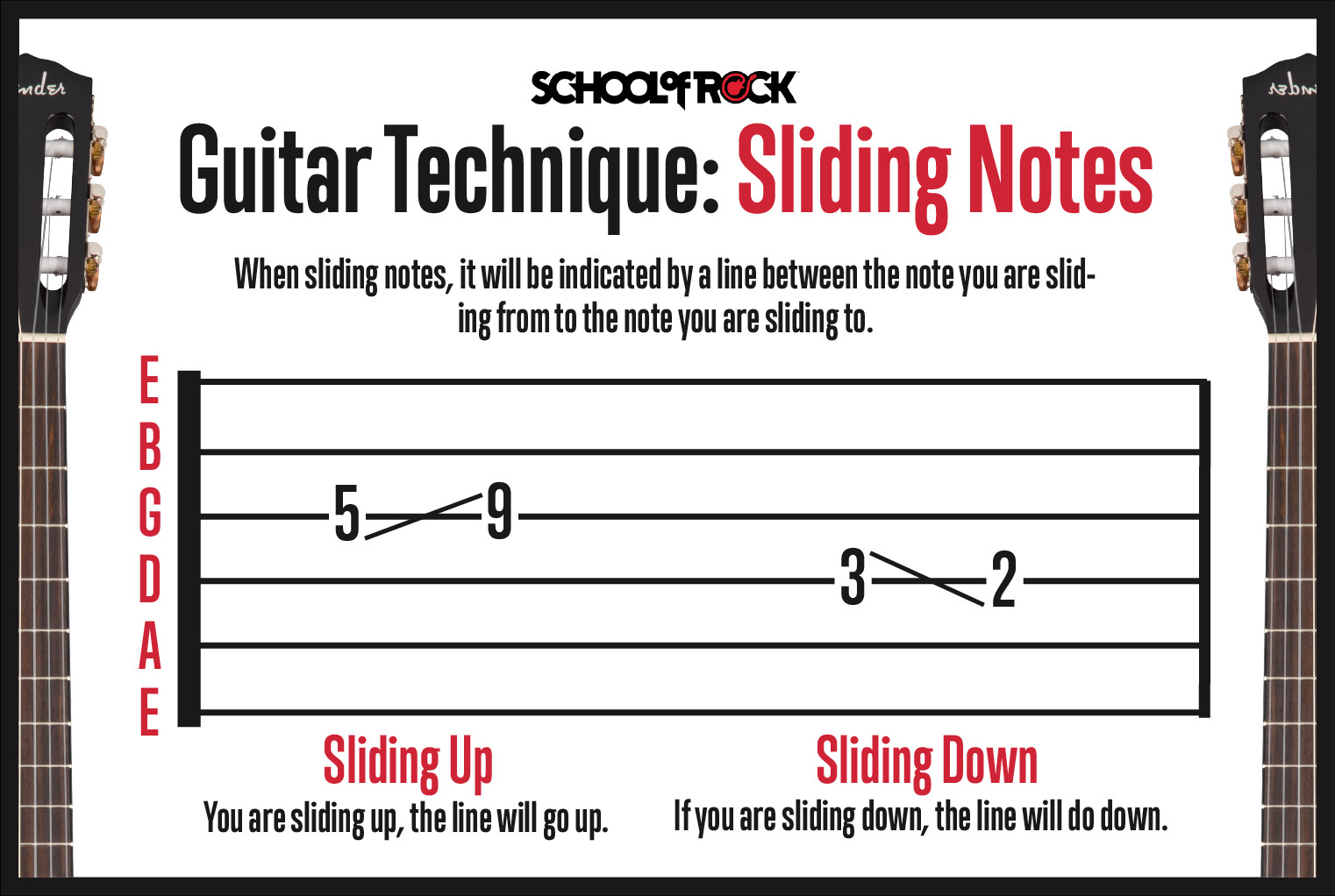 Guitar Slide Up Technique
Guitar Slide Up Technique
Guitar tab example showing an upward slanting line between notes to indicate a slide up technique.
Slide Down
Conversely, a slide down is when you slide from a higher-pitched note to a lower-pitched note. In guitar tabs, a slide down is shown by a line slanting downwards () connecting the fret number you are sliding from to the fret number you are sliding to.
Hammer-Ons in Guitar Tabs
A hammer-on is a guitar technique where you produce a note by “hammering” your fretting finger onto the string behind a fret, rather than picking the string again. It’s a way to articulate a note from a lower pitch to a higher pitch without using the picking hand.
In guitar tabs, hammer-ons are indicated by the letter “h” placed between two notes, often connected by a curved arc above the notes. The first number represents the starting note (which is picked), and the second number (after the “h”) is the note you “hammer-on” to.
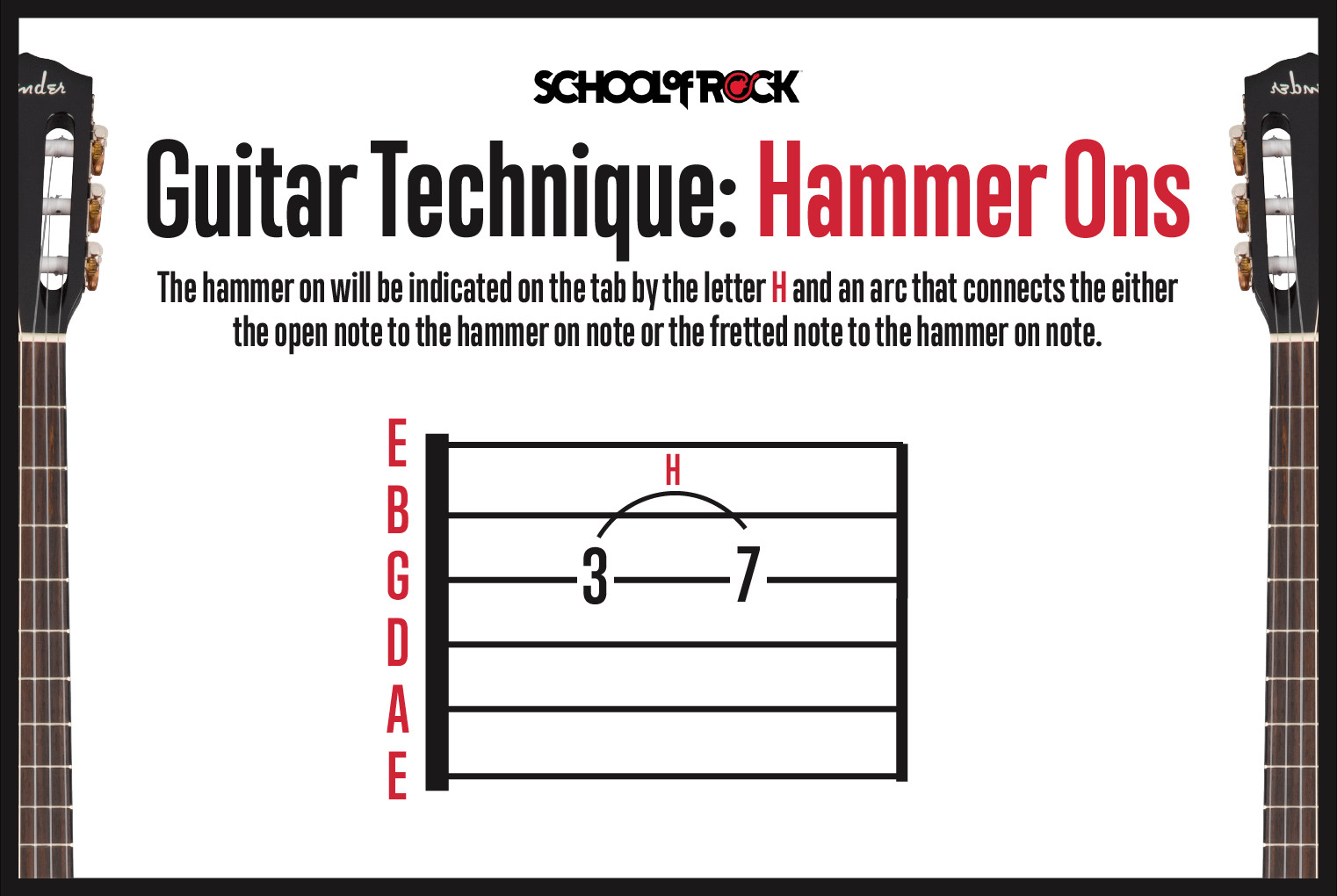 Guitar Hammer-On Technique
Guitar Hammer-On Technique
Guitar tab example using “h” and a curved arc to indicate a hammer-on technique.
Pull-Offs in Guitar Tabs
A pull-off is the opposite of a hammer-on. It’s a technique where you articulate a note by “pulling off” a fretting finger from a string, causing the string to sound a lower-pitched note that was already being fretted by another finger. Like hammer-ons, pull-offs allow you to play legato passages without constant picking.
In guitar tabs, pull-offs are indicated by the letter “p” placed between two notes, often connected by a curved arc above the notes. The first number represents the higher-pitched note you are starting on, and the second number (after the “p”) is the lower-pitched note that sounds when you pull-off.
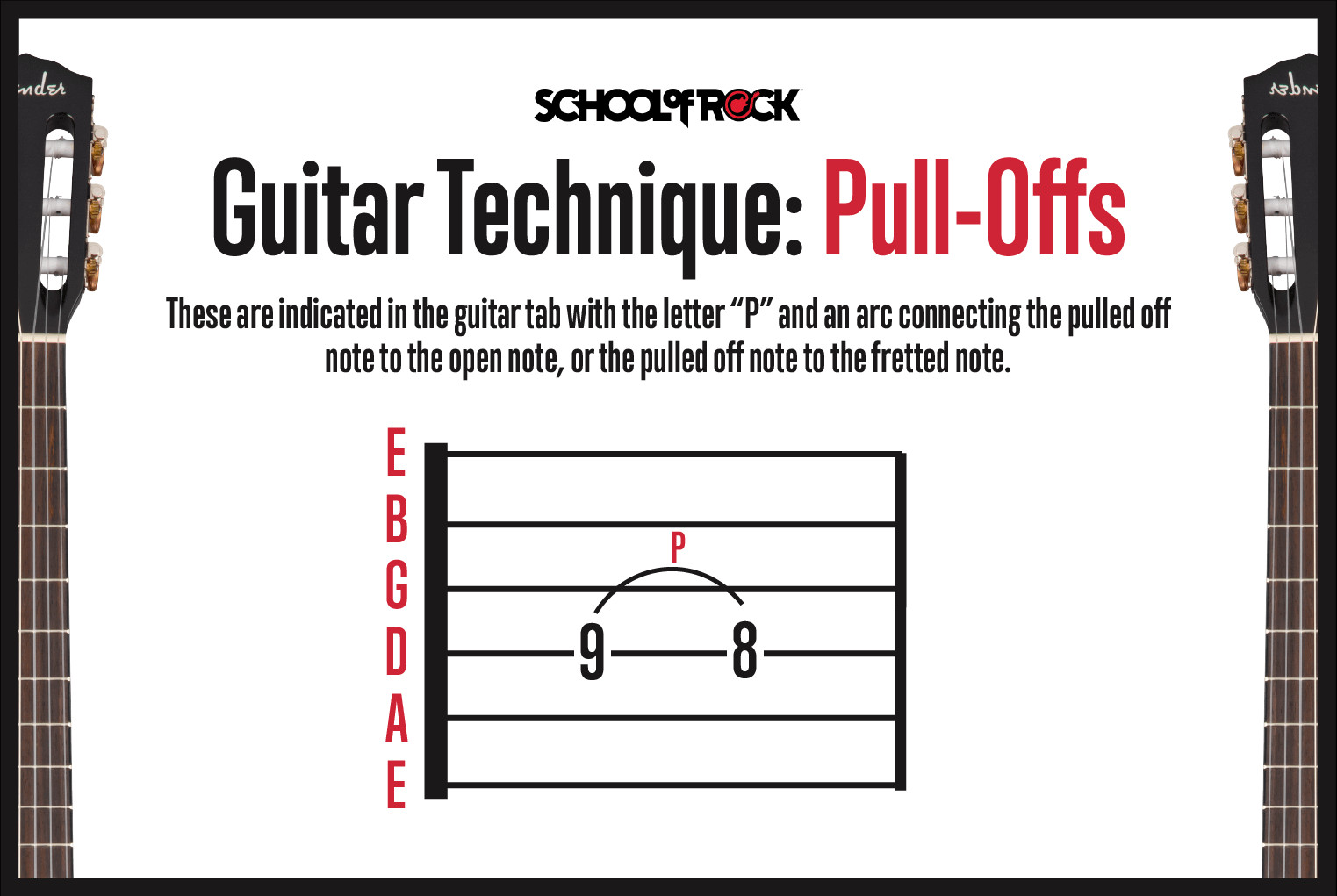 Guitar Pull-Off Technique
Guitar Pull-Off Technique
Guitar tab example using “p” and a curved arc to indicate a pull-off technique.
Vibrato in Guitar Tabs
Vibrato is a technique used to add warmth, expression, and sustain to a note. It involves subtly and rapidly varying the pitch of a note, usually by rocking the fretting finger back and forth along the string axis without releasing pressure.
In guitar tabs, vibrato is often represented by a wavy or zig-zag line extending from the note. The length of the zig-zag line can sometimes indicate the duration of the vibrato. The intensity and speed of vibrato are often a matter of personal style and musical context, and tabs provide a visual cue to include this expressive technique.
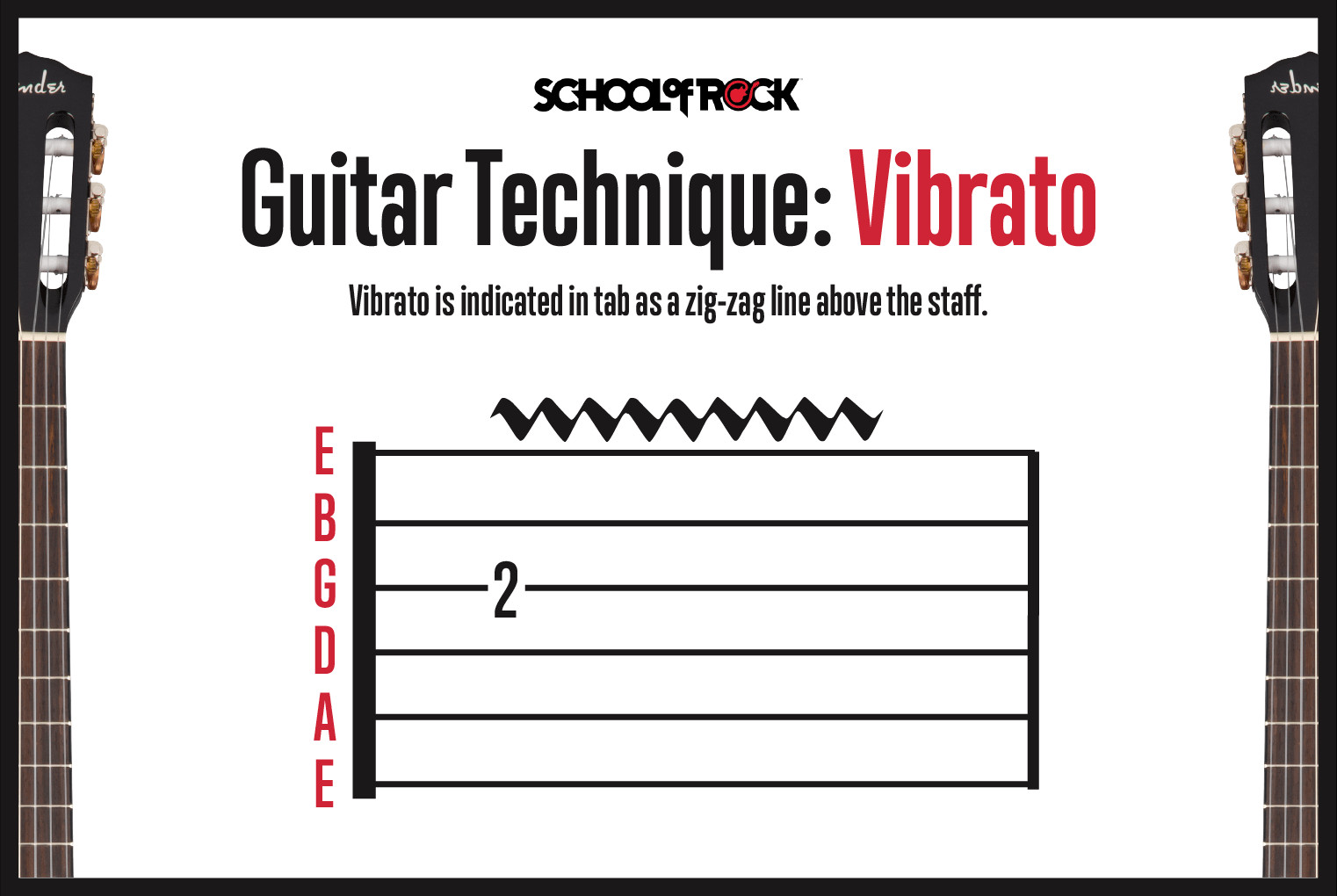 Guitar Vibrato Technique
Guitar Vibrato Technique
Guitar tab example showing a zig-zag line above a note to indicate a vibrato technique.
Tapping in Guitar Tabs
Tapping, popularized by guitarists like Eddie Van Halen, is a technique where you fret notes by “tapping” or hammering on the fretboard with a finger from your picking hand, in addition to using your regular fretting hand. This allows for fast, legato playing and wide intervals.
In guitar tabs, tapping is typically indicated by a “T” above the tapped note. The tab will show the fret number to be tapped, and often, a “+” sign might be used to indicate the tapping hand.
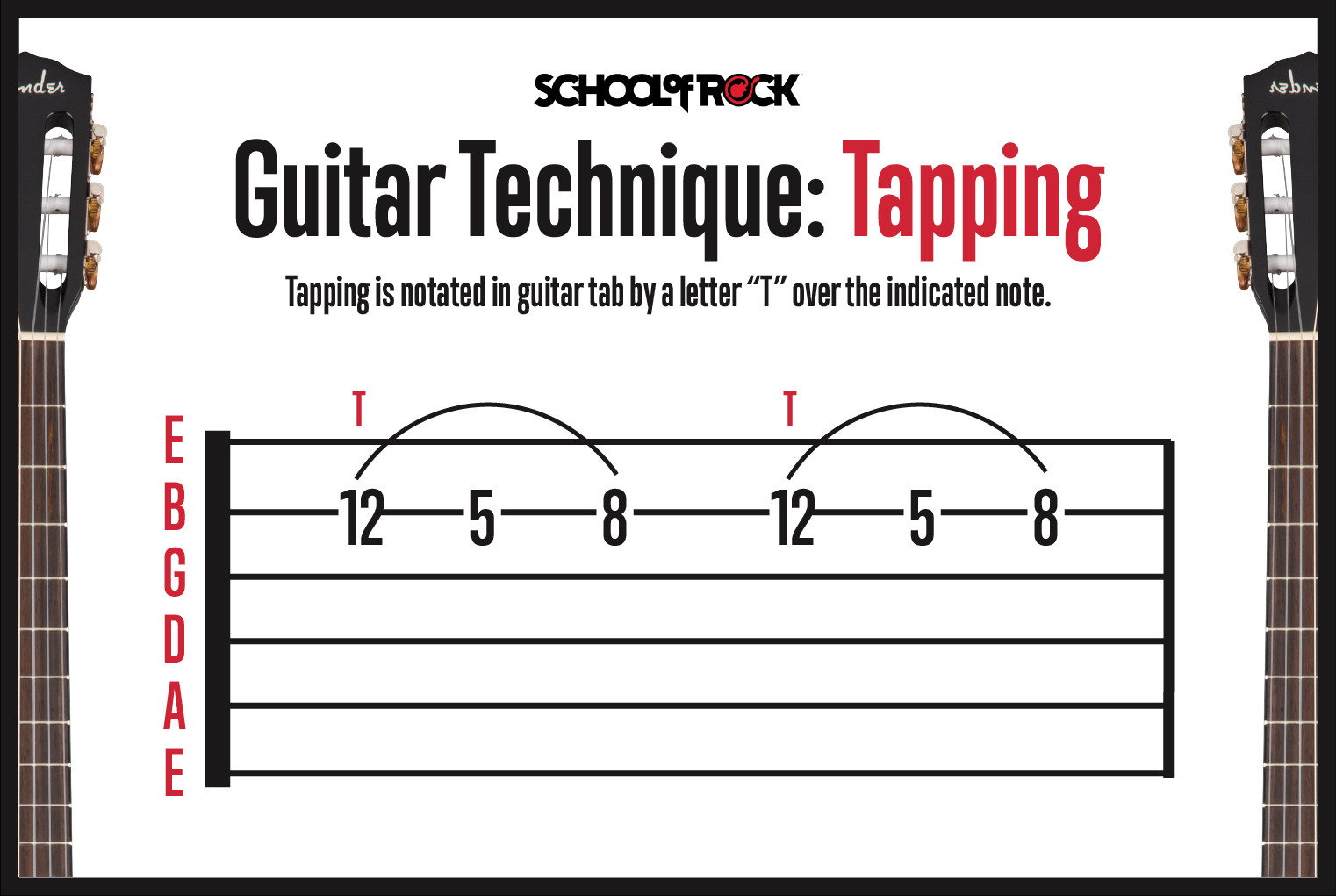 Guitar Tapping Technique
Guitar Tapping Technique
Guitar tab example using “T” above a note to indicate a tapping technique.
Two-Handed Tapping
Two-handed tapping expands on the tapping technique by involving both the fretting hand and the picking hand to independently tap notes on the fretboard. This can create complex textures and polyphonic lines. Tabs for two-handed tapping will show “T” symbols for notes tapped by both hands, and context within the music usually clarifies which hand is tapping which notes. Sometimes, notation will differentiate hands (e.g., “T” for picking hand tap, and perhaps a different symbol for fretting hand tap).
Strumming in Guitar Tabs
When tabs represent strummed chords, they sometimes include symbols to indicate strumming direction: downstrokes and upstrokes. These symbols help convey the rhythm and feel of strummed passages.
Downstrokes and Upstrokes
A downstroke is when you strum downwards across the strings, typically from the lower strings towards the higher strings. In guitar tabs, a downstroke is often symbolized by a thick horizontal line with two short vertical “legs” pointing downwards on either side of the line.
An upstroke is the opposite: strumming upwards across the strings, from the higher strings towards the lower strings. In guitar tabs, an upstroke is often symbolized by a “V” shape placed above the strummed chord.
These strumming symbols are especially helpful for learning specific strumming patterns and rhythms in songs. Often, songs use a combination of downstrokes and upstrokes to create rhythmic grooves. Eighth note rhythms, for example, frequently alternate downstrokes on the beat and upstrokes on the “and” counts (1 & 2 & 3 & 4 &).
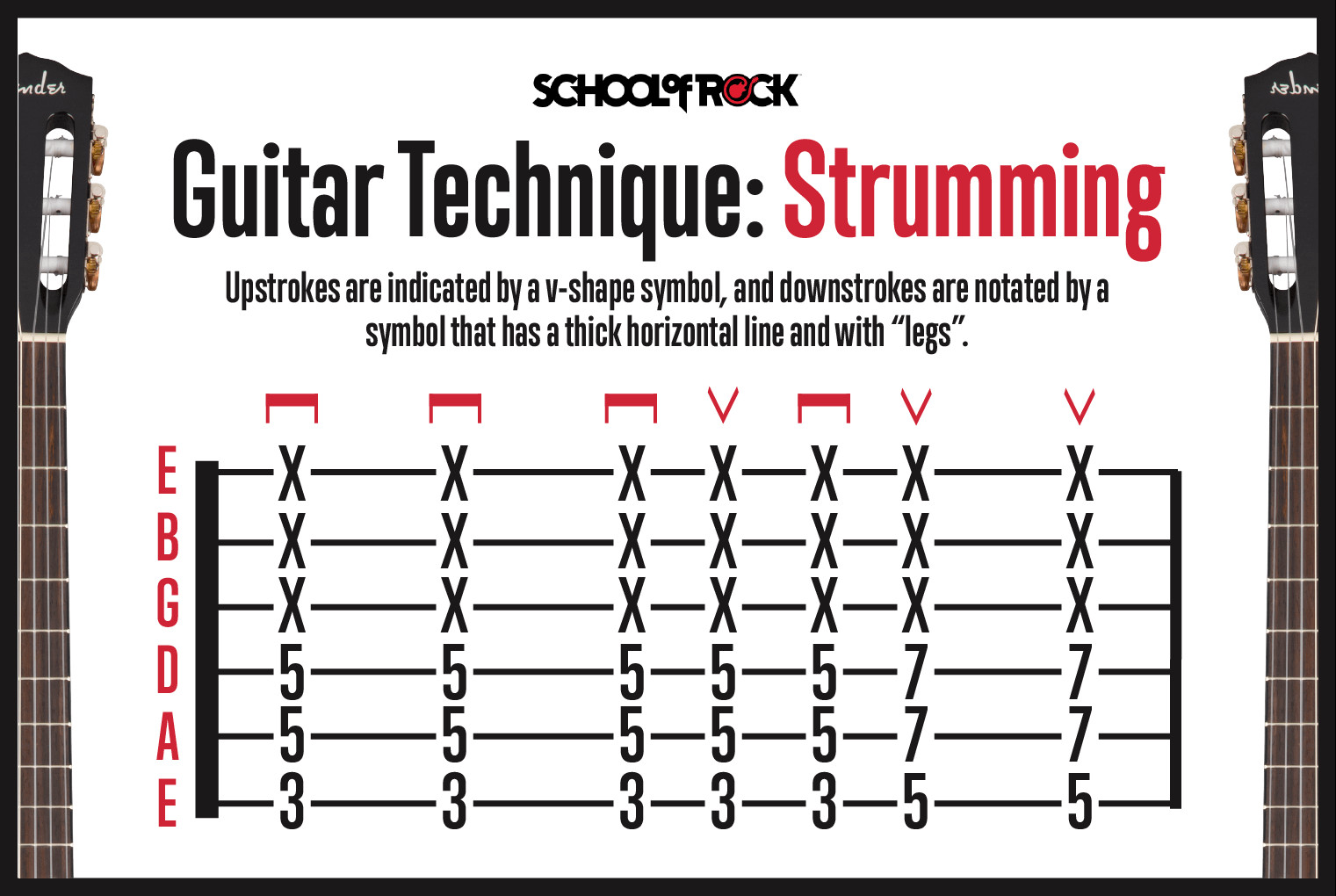 Guitar Strumming Technique
Guitar Strumming Technique
Guitar tab example showing downstroke and upstroke symbols to indicate strumming direction.
Conclusion: Start Playing Guitar Tabs Today!
Now that you’ve learned the fundamentals of how to read guitar tabs and understand common guitar tab symbols and techniques, you’re well-equipped to start playing a vast library of songs! Guitar tabs offer an accessible and direct pathway into playing music on the guitar, especially for beginners. They bypass the complexities of standard music notation and visually guide you on the fretboard.
Whether you’re interested in strumming chords, playing riffs, or mastering advanced techniques, guitar tabs can be your invaluable tool. So, grab your guitar, find some tabs for your favorite songs, and start exploring the world of music through tablature.
Ready to take your guitar journey further? At guitarplayers.net, we are dedicated to helping guitarists of all levels improve their skills and reach their musical goals. Explore our resources for more in-depth lessons and techniques. And if you’re looking for a wide selection of sheet music and guitar tabs, check out Sheet Music Direct for a vast and growing library.
Thinking about getting a new guitar to fuel your musical passion? Don’t miss our comprehensive Guitar Buying Guide!
